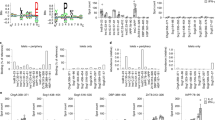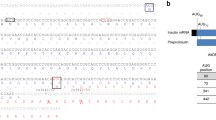Abstract
Background
Insulin (1) and glutamic acid decarboxylase (GAD) (2) are both autoantigens in insulin-dependent diabetes mellitus (IDDM), but no molecular mechanism has been proposed for their association. We have identified a 13 amino acid peptide of proinsulin (amino acids 24–36) that bears marked similarity to a peptide of GAD65 (amino acids 506–518) (G. Rudy, unpublished). In order to test the hypothesis that this region of similarity is implicated in the pathogenesis of IDDM, we assayed T cell reactivity to these two peptides in subjects at risk for IDDM.
Materials and Methods
Subjects at risk for IDDM were islet cell antibody (ICA)-positive, first degree relatives of people with insulin-dependent diabetes. Peripheral blood mononuclear cells from 10 pairs of at-risk and HLA-DR matched control subjects were tested in an in vitro proliferation assay.
Results
Reactivity to both proinsulin and GAD peptides was significantly greater among at-risk subjects than controls (proinsulin; p < 0.008; GAD: p < 0.018). In contrast to reactivity to the GAD peptide, reactivity to the proinsulin peptide was almost entirely confined to the at-risk subjects.
Conclusions
This is the first demonstration of T cell reactivity to a proinsulin-specific peptide. In addition, it is the first example of reactivity to a minimal peptide region shared between two human autoimmune disease-associated self antigens. Mimicry between these similar peptides may provide a molecular basis for the conjoint autoantigenicity of proinsulin and GAD in IDDM.


Similar content being viewed by others
References
Palmer JP, Asplin CM, Clemons P, et al. (1983) Insulin antibodies in insulin-dependent diabetics before insulin treatment. Science 222(4630): 1337–1339.
Baekkeskov S, Aanstoot HJ, Christgau S, et al. (1990) Identification of the 64K autoantigen in insulin-dependent diabetes as the GABA-synthesizing enzyme glutamic acid decarboxylase. Nature 347(6289): 151–156.
Honeyman MC, Harrison LC. (1993) The immunologic insult in type 1 diabetes. Springer Semin. Immunopathol 14(3): 253–274. Review.
Bottazzo GF, Dean BM, McNally JM, MacKay EH, Swift PGF, Gamble DR. (1985) In situ characterization of autoimmune phenomena and expression of HLA molecules in the pancreas in diabetic insulitis. N. Engl. J. Med. 313(6): 353–360.
Foulis AK, McGill M, Farquharson MA. (1991) Insulitis in type 1 (insulin-dependent) diabetes mellitus in man—Macrophages, lymphocytes, and interferon-gamma containing cells. J. Pathol. 165(2): 97–103.
Hanninen A, Jalkanen S, Salmi M, Toikkanen S, Nikolakaros G, Simell O. (1992) Macrophages, T cell receptor usage, and endothelial cell activation in the pancreas at the onset of insulin-dependent diabetes mellitus. J. Clin. Invest. 90(5): 1901–1910.
Hanafusa T, Miyazaki A, Miyagawa J, et al. (1990) Examination of islets in the pancreas biopsy specimens from newly diagnosed type 1 (insulin-dependent) diabetic patients. Diabetologia 33(2): 105–111.
Itoh N, Hanafusa T, Miyazaki A, et al. (1993) Mononuclear cell infiltration and its relation to the expression of major histocompatibility complex antigens and adhesion molecules in pancreas biopsy specimens from newly diagnosed insulin-dependent diabetes mellitus patients. J. Clin. Invest. 92(5): 2313–222.
Sibley RK, Sutherland DER, Goetz F, Michael AF. (1985) Recurrent diabetes mellitus in the pancreas iso- and allograft. A light and electron microscopic and immunohistochemical analysis of four cases. Lab. Invest. 53(2): 132–144.
Dupre J, Stiller CR. (1989) Summary and critical evaluation of immunosuppression trials in recent-onset type 1 diabetes. In: Andreani D, Kolb H, Pozzilli P (eds). Immunotherapy of Type I Diabetes. John Wiley & Sons, London, United Kingdom, pp. 125–136.
Harrison LC. (1992) Islet cell antigens in insulin-dependent diabetes: Pandora’s box revisited [see comments]. Immunol Today 13(9): 348–352. Review.
Bohmer K, Keilacker H, Kuglin B, et al. (1991) Proinsulin autoantibodies are more closely associated with type 1 (insulin-dependent) diabetes mellitus than insulin autoantibodies. Diabetologia 34(11): 830–834.
Ziegler AG, Hillebrand B, Rabl W, et al. (1993) On the appearance of islet associated autoimmunity in offspring of diabetic mothers: a prospective study from birth. Diabetologia 36(5): 402–408.
Harrison LC, De Aizpurua H, Loudovaris T, et al. (1991) Reactivity to human islets and fetal pig proislets by peripheral blood mononuclear cells from subjects with preclinical and clinical insulin-dependent diabetes. Diabetes 40(9): 1128–1133.
Harrison LC, Chu SX, DeAizpurua HJ, et al. (1992) Islet-reactive T cells are a marker of preclinical insulin-dependent diabetes. J. Clin. Invest. 89(4): 1161–1165.
Honeyman MC, Cram DS, Harrison LC. (1993) Glutamic acid decarboxylase 67-reactive T cells: A marker of insulin-dependent diabetes. J. Exp. Med. 177(2): 535–540.
Atkinson MA, Bowman MA, Campbell L, Darrow BL, Kaufman DL, Maclaren NK. (1994) Cellular immunity to a determinant common to glutamate decarboxylase and Coxsackie virus in insulin-dependent diabetes. J. Clin. Invest. 94(5): 2125–2129.
Lohmann T, Leslie R, Hawa M, Gey sen M, Rodda SM. (1994) Immunodominant epitopes of glutamic acid decarboxylase 65 and 67 in insulin dependent diabetes mellitus. Lancet 343(8913): 1607–1608.
Wegmann DR, Norbury-Glaser M, Daniel D. (1994) Insulin-specific T cells are a predominant component of islet infiltrates in prediabetic NOD mice. Eur. J. Immunol 24(8): 1853–1857.
Kaufman DL, Clare-Salzler M, Tian J, et al. (1993) Spontaneous loss of T-cell tolerance to glutamic acid decarboxylase in murine insulindependent diabetes. Nature 366(6450): 69–72.
Davidson HW, Rhodes CJ, Hutton JC. (1988) Intraorganellar calcium and pH control proinsulin cleavage in the pancreatic beta cell via two distinct site-specific endopeptidases. Nature 333(6168): 93–96.
Schmidli RS, DeAizpurua HJ, Harrison LC, Colman PG. (1994) Antibodies to glutamic acid decarboxylase in at-risk and clinical insulin-dependent diabetic subjects: Relationship to age, sex and islet cell antibody status, and temporal profile. J. Autoimmun. 7(1): 55–66.
Snorgaard O, Hartling SG, Binder C. (1990) Proinsulin and C-peptide at onset and during 12 months cyclosporin treatment of type 1 (insulin-dependent) diabetes mellitus [see comments]. Diabetologia 33(1): 36–42.
Heaton DA, Millward BA, Gray IP, et al. (1988) Increased proinsulin levels as an early indicator of B-cell dysfunction in non-diabetic twins of type 1 (insulin-dependent) diabetic patients. Diabetologia 31(3): 182–184.
Hartling SG, Lindgren F, Dahlqvist G, Persson B, Binder C. (1989) Elevated proinsulin in healthy siblings of IDDM patients independent of HLA identity. Diabetes 38(10): 1271–1274.
Lindgren FA, Hartling SG, Persson BE, et al. (1993) Proinsulin levels in newborn siblings of type 1 (insulin-dependent) diabetic children and their mothers. Diabetologia 36(6): 560–563.
Spinas GA, Snorgaard O, Hartling SG, Oberholzer M, Berger W. (1992) Elevated proinsulin levels related to islet cell antibodies in first-degree relatives of IDDM patients. Diabetes Care 15(5): 632–637.
Kuglin B, Gries FA, Kolb H. (1988) Evidence of IgG autoantibodies against human proinsulin in patients with IDDM before insulin treatment. Diabetes 37(1): 130–132.
Kuglin B, Halder B, Bertrams J, Gruneklee D, Gries FA, Kolb H. (1990) Proinsulin autoantibodies: association with type I diabetes but not with islet cell antibodies, insulin autoantibodies or HLA-DR type. J. Autoimmun. 3(5): 573–577.
Luo AM, Garza KM, Hunt D, Tung KSK. (1993) Antigen mimicry in autoimmune disease sharing of amino acid residues critical for pathogenic T cell activation. J. Clin. Invest. 92(5): 2117–2123.
Hurtenbach U, Lier E, Adorini L, Nagy ZA. (1993) Prevention of autoimmune diabetes in non-obese diabetic mice by treatment with a class II major histocompatibility complex-blocking peptide. J. Exp. Med. 177(5): 1499–1504.
Taki T, Nagata M, Ogawa W, et al. (1991) Prevention of cyclophosphamide-induced and spontaneous diabetes in NOD/Shi/Kbe mice by anti-MHC class I Kd monoclonal antibody. Diabetes 40(9): 1203–1209.
Romero P, Corradin G, Luescher IF, Maryanski JL. (1991) H-2Kd-restricted antigenic peptides share a simple binding motif. J. Exp. Med. 174(3): 603–612.
Reich EP, Von Grafenstein H, Barlow A, Swenson KE, Williams K, Janeway CA. (1994) Self peptides isolated from MHC glycoproteins of nonobese diabetic mice. J. Immunol 152(5): 2279–2288.
Deng H, Apple R, Clare-Salzler M, et al. (1993) Determinant capture as a possible mechanism of protection afforded by major histocompatibility complex class II molecules in autoimmune disease. J. Exp. Med. 178(5): 1675–1680.
Tian J, Lehmann PV, Kaufman DL. (1994) T cell cross-reactivity between coxsackievirus and glutamate decarboxylase is associated with a murine diabetes susceptibility allele. J. Exp. Med. 180(5): 1979–1984.
Butler MH, Solimena M, Dirkx R, Hayday A, De Camilli P. (1993) Identification of a dominant epitope of glutamic acid decarboxylase (GAD-65) recognized by autoantibodies in stiff-man syndrome. J. Exp. Med. 178(6): 2097–2106.
Richter W, Shi Y, Baekkeskov S. (1993) Autoreactive epitopes defined by diabetes-associated human monoclonal antibodies are localized in the middle and C-terminal domains of the smaller form of glutamate decarboxylase. Proc. Natl. Acad. Sci. U.S.A. 90(7): 2832–2836.
Shimoda S, Nakamura M, Ishibashi H, Hayashida K, Niho Y. (1995) HLA DRB4 0101-restricted immunodominant T cell autoepitope of pyruvate dehydrogenase complex in primary biliary cirrhosis: Evidence of molecular mimicry in human autoimmune diseases. J. Exp. Med. 181(5): 1835–1845.
Graham S, Wang ECY, Jenkins O, Borysiewicz LK. (1993) Analysis of the human T-cell response to picornaviruses: Identification of T-cell epitopes close to B-cell epitopes in poliovirus. J. Virol. 67(3): 1627–1637.
Lin RH, Mamula MJ, Hardin JA, Janeway CA. (1991) Induction of autoreactive B cells allows priming of autoreactive T cells. J. Exp. Med. 173(6): 1433–1439.
Campbell IL, Oxbrow L, West J, Harrison LC. (1988) Regulation of MHC protein expression in pancreatic beta-cells by interferongamma and tumor necrosis factor-alpha. Mol. Endocrinol 2(2): 101–107.
Campbell IL, Cutri A, Wilkinson D, Boyd AW, Harrison LC. (1989) Intercellular adhesion molecule 1 is induced on isolated endocrine islet cells by cytokines but not by reovirus infection. Proc. Natl. Acad. Sci. U.S.A. 86(11): 4282–4286.
Tisch R, Yang XD, Singer SM, Liblau RS, Fugger L, McDevitt HO. (1993) Immune response to glutamic acid decarboxylase correlates with insulitis in non-obese diabetic mice. Nature 366(6450): 72–75.
Acknowledgments
The authors express their appreciation to Margaret Thompson for secretarial assistance and thank the Victorian Health Promotion Foundation for their support. GR is a recipient of a National Health and Medical Research Council fellowship. MBF was a recipient of a Medical Research Council of Canada fellowship.
Author information
Authors and Affiliations
Rights and permissions
About this article
Cite this article
Rudy, G., Stone, N., Harrison, L.C. et al. Similar Peptides from Two β Cell Autoantigens, Proinsulin and Glutamic Acid Decarboxylase, Stimulate T Cells of Individuals at Risk for Insulin-Dependent Diabetes. Mol Med 1, 625–633 (1995). https://doi.org/10.1007/BF03401603
Published:
Issue Date:
DOI: https://doi.org/10.1007/BF03401603




